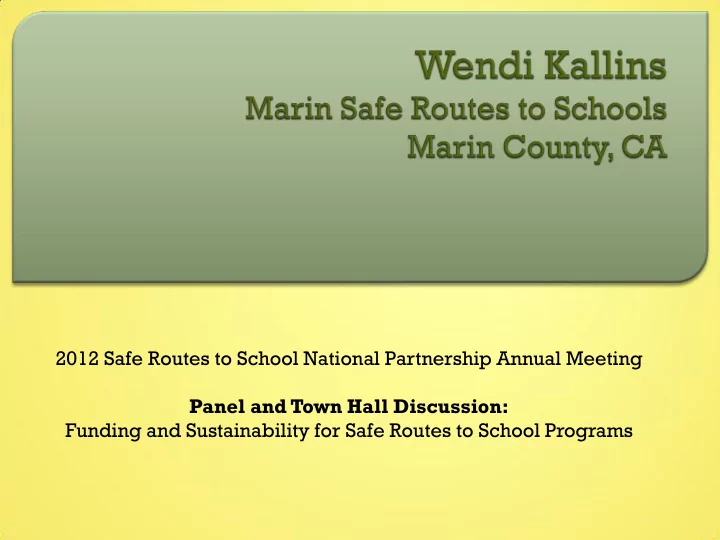

2012 Safe Routes to School National Partnership Annual Meeting Panel and Town Hall Discussion: Funding and Sustainability for Safe Routes to School Programs
• 20 year Sales Tax • 11% dedicated to Safe Access to Schools • Funds program, crossing guards and infrastructure
• Fourth try for a Transportation Sales tax in Marin • In California need 2/3 majority • Safe Routes to Schools program already known from the pilot program • SR2S Polled highest of all the other categories • MCBC was a key partner in the campaign • Sales tax won by 72%
• Broad coalition supported the tax • Transit • Highway • Roads • Walking and biking • Schools • CMA Leadership championed SR2S
• Taxes are never an easy sell • Transportation and School taxes tend to have the best chance of passage • SR2S combined transportation with school interests • Have your advocates be a constant presence at all meetings • Make sure SR2S is included in polling
• SR2S Task Forces have created strong relationships • The schools have come to rely on SR2S for classroom lessons and alleviating traffic congestion • Comprehensive policies • PTA SR2S Committees • Looking for more ways to institutionalize
2012 Safe Routes to School National Partnership Annual Meeting Panel and Town Hall Discussion: Funding and Sustainability for Safe Routes to School Programs
1. Child Safety Zones Ordinance
Chicago Schools Automated Speed Enforcement Reinvestment & Revenue
Child Safety Zone Committee Mayor’s Office Commissioner of Transportation Elected Officials Public Health Police Department Regional Planning Hospitals School District Park District
Engagement Leadership Enforcement in Dialog
Citywide Implementation 10 Year Roll-out Renewable Funding Source Maintenance
2012 Safe Routes to School National Partnership Annual Meeting Panel and Town Hall Discussion: Funding and Sustainability for Safe Routes to School Programs
The Nashville Area MPO 2035 Regional Transportation Plan significantly increased policy and funding for bicycle and pedestrian education and infrastructure • 60% of the scoring criteria for roadway projects relate to improving health, safety and active transportation 15% of the MPO Surface • Transportation Program funds are reserved in an Active Transportation Grant program (funds infrastructure and education)
2009 Regional Bicycle and Pedestrian Study • 2,400 people provide input Themes: more facilities • facilities that connect supportive culture Household Transportation Survey • 1,100 random-dial households Prioritizing Transportation $: • 1. Transit 2. Walking/Bicycling 3. Build Roadways
Residents/Workers in Middle TN • Mayors • • Partners Showcasing other cities Health: CDC TN Obesity Taskforce
Adopted a Complete Streets Policy • but did not call it by a name Encouraged leaders to adopt these • policies even without supporting data • Discussion started out with community vision, not the words health, bicycle or pedestrian
Bev Brody Health & Built Environment Project Facilitator Get Fit Kauai Nutrition & Physical Activity Coalition of Kauai, Hawaii
Policy Success – HB 2626 • Surcharge on all traffic violations ($10 and $25) • $$ stay in each county (first time in Hawaii Legislature history) Kauai Oahu
The Campaign Step 1 Step 2 Step 3 The Idea The Campaign The Media • Get buy-in • All eggs in • Social 2 baskets from Rep • Newspaper Kawakami • State-wide • Radio effort • Television
Champions & Partners • Representative Derek Kawakami • Mayor Bernard Carvalho • Deputy County Engineer, Lyle Tabata • Kauai County Council • Department of Health • HDOT • County Housing Agency • Planning Department • AARP • KPD • 80 community members
Lessons Learned Positive Lessons Learned • Success depends greatly on the quality of relationships. • It is possible to pass legislation the first time ‘round. • Sometimes you don’t need talent or a lot of knowledge, you just need enthusiasm and passion . Other Lessons Learned • Learn to educate opposed to advocate (no call to action) • It can be a frustrating process and things can change at the last minute!
What’s Next? • $250,000.00 Statewide Cap • In 2009 53,798 traffic tickets were issued (approx. $775.00.00) • Organize an advocacy and education group statewide to address the cap. • Requesting at least 50% of the $$ raised go towards SRTS Statewide.
2012 Safe Routes to School National Partnership Annual Meeting Panel and Town Hall Discussion: Funding and Sustainability for Safe Routes to School Programs
• GOAL: SRTS account and $3M appropriation in 2012 MN Bonding Bill Bicycle Alliance of MN, MN Safe Routes to • School Network, MN Safe Kids Coalition, American Heart Association, American Cancer Society, MN Childhood Obesity Legislative Working Group and Blue Cross Blue Shield of MN (34 partners) • $3,000 Advocacy Advance grant for lobbyist Omnibus Transportation law - May 10, 2012 • (SF1439/HF1429) SRTS Program, Account, Bond Eligibility, • Admin 2013 – Go For the Money! •
Arizona School Zone Double Fines (28-797) - 1997 • > 20 mph double fine, no exceptions Minimum $200 fine • • Where Stop When Children in Crosswalk Fines Double signs are present Illinois School Zone Fines (ILCS 5/11-605) - 2011 • Speed violation is $150 or greater, then additional $50 fine Paid to the unit school district where the violation occurred for school • safety purposes – eligibility includes SRTS. Washington School Zone Maximum Speed (RCW 46.63.110) -1996 > 20 mph double fine, no exceptions • 50% to improve school zone safety, pupil • transportation safety, and student safety in school bus loading and unloading areas. Up to 500K public education; 1.5M • enforcement
Portland CSTSP program – 2003 - current • Slows traffic, reducing crashes Creates revenue for SRTS • Pays for traffic calming equipment, education • Process : 1. Build Partners 2. State legislative ‘tweak’ 3. City Council Approval 4. Launch of SRTS Program in 2004 Results : 5E’s Pilot Program in 2005 – 8 schools • Now in over 80 schools • • 32% increase in walking and biking Citywide SRTS Policy •
• Slows traffic, reducing crashes Creates revenue for SRTS • • Pays for traffic calming equipment, education
Recommend
More recommend